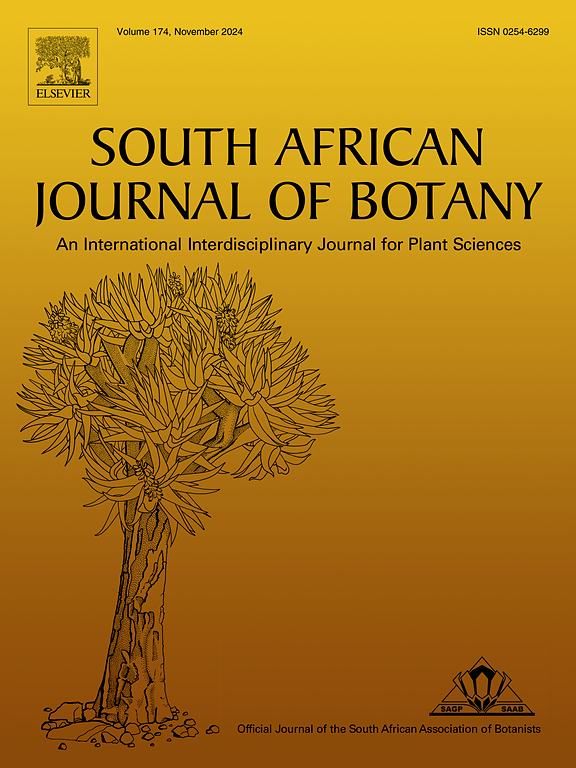大戟的微繁繁殖。生物引导下对其生物活性成分进行初步植物化学研究
IF 2.7
3区 生物学
Q2 PLANT SCIENCES
引用次数: 0
摘要
大戟。是一种生长缓慢的分枝园艺植物,通常大量用于园林绿化街道和花园;传统上,它也被用于各种医疗目的。因此,迫切需要设计一种能大批量生产健康植株的微繁方法。本研究主要研究了密莲的取穗、生根行为、驯化和生化成分。芽尖和腋芽无菌后,在添加0.2 mg/L萘乙酸(NAA)的Murashige和Skoog (MS)培养基上培养,芽出芽率为86.67%,芽长为0.73 cm。以1.0 mg/L苄氨基嘌呤(BAP)和0.2 mg/L NAA的添加量为1.0 mg/L时,茎长最长(1.5 cm),不同强度MS培养基中添加1.0 g/L的活性炭时,茎长(2.90 cm)、叶数/茎长(4.33 cm)、根数/茎长(3.67 cm)和根长(5.70 cm)效果最佳。驯化苗在泥炭和沙地上的存活率为100% (1:1 v/v)时,苗高、叶数/苗、根数/苗和根长均达到最大值。在MS培养基上添加2.0 mg/L动素(Kin)和0.2 mg/L NAA的芽苗培养液中,总多酚含量、总抗氧化能力、铁还原能力、1,1-二苯基-2-吡啶-肼(DPPH)、2,2′-氮化喹啉-(3-乙基苯并噻唑-6-磺酸)、抗糖尿病活性和抗炎活性最高。另一方面,在无激素培养基(对照)和含1.0 mg/L异戊烯腺嘌呤+0.2 mg/L NAA培养基上培养的嫩枝甲醇水提物抗阿尔茨海默病活性增强。在含有2.0 mg/L Kin + 0.2 mg/L NAA的培养基上,对最具生物活性的培养物的脂肪物质部分进行气相色谱- fid分析,鉴定出以棕榈酸为主要成分的16种化合物,面积百分比为67.34%。同样,HPLC分析脱脂部分检测并定量了13种酚类化合物,主要存在没食子酸(6257.84µg/g)。本研究提供了一种成功的离体繁殖方法,并首次对培养物进行了植物化学分析和离体生物学评价。本文章由计算机程序翻译,如有差异,请以英文原文为准。

Micropropagation of Euphorbia milii Des Moul. with bioguided preliminary phytochemical studies of its bioactive constituents
Euphorbia milii Des Moul. is a slow-growing branching horticulture plant commonly used in large quantities in landscaping streets and gardens; it has also been traditionally used for various medicinal purposes. So, there is an urgent need to design a micropropagation method for the production of a large number of healthy plants. In the present study, shooting establishment, rooting behavior, acclimatization, and biochemical constituents of E. milii were examined. Shoot tip and axillary bud free contamination were sterilized and cultured on Murashige and Skoog (MS) medium fortified with 0.2 mg/L naphthalene acetic acid (NAA) to give the best bud sprouting percentage (86.67 %) and bud length (0.73 cm). The adding of 1.0 mg/L benzyl aminopurine (BAP) with 0.2 mg/L NAA recorded the longest shootlet length (1.5 cm), while different strengths of MS medium with 1.0 g/L activated charcoal produced the best results for shootlet length (2.90 cm), leaf number/shootlet (4.33), root number/shootlet (3.67), and root length (5.70 cm). 100 % survival rate of acclimatized plantlets on peat and sand (1:1 v/v) resulted in maximum plantlet height, leaf number/plantlet, root number/plantlet, and root length. The aqueous methanol extracts of shootlet cultures on MS medium fortified with 2.0 mg/L kinetin (Kin) and 0.2 mg/L NAA recorded the highest amount of total polyphenol, total antioxidant capacity, iron-reducing power, 1,1-Diphenyl-2-picryl-hydrazyl (DPPH), 2,2′-azinobis-(3-ethylbenzothiazoline-6-sulfonic acid) (ABTS), anti-diabetic activity, and anti-inflammatory activity. On the other hand, anti-Alzheimer activity increased in the aqueous methanol extracts of shootlet culture on medium-free hormone (control and medium containing 1.0 mg/L Isopentenyl adenine +0.2 mg/L NAA. The fatty matter fraction of the most bioactive culture on a medium containing 2.0 mg/L Kin + 0.2 mg/L NAA was subjected to GC-FID, which revealed the identification of 16 compounds with palmitic acid as the predominant constituent in the extract, with an area percentage of 67.34 %. Similarly, HPLC analysis of the defatted fraction detected and quantified 13 phenolic compounds, with a major occurrence of gallic acid (6257.84 µg/g). The current research provides a successful method for in vitro propagation of E. milii and the first investigation of the phytochemical analysis with in vitro biological evaluation of the cultures.
求助全文
通过发布文献求助,成功后即可免费获取论文全文。
去求助
来源期刊

South African Journal of Botany
生物-植物科学
CiteScore
5.20
自引率
9.70%
发文量
709
审稿时长
61 days
期刊介绍:
The South African Journal of Botany publishes original papers that deal with the classification, biodiversity, morphology, physiology, molecular biology, ecology, biotechnology, ethnobotany and other botanically related aspects of species that are of importance to southern Africa. Manuscripts dealing with significant new findings on other species of the world and general botanical principles will also be considered and are encouraged.
 求助内容:
求助内容: 应助结果提醒方式:
应助结果提醒方式:


